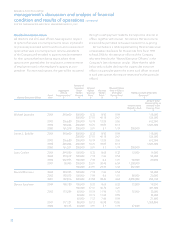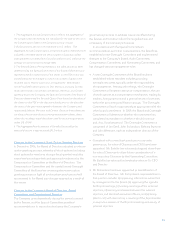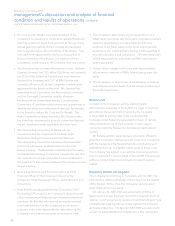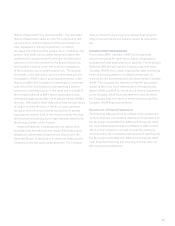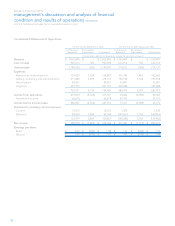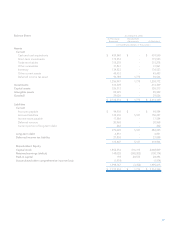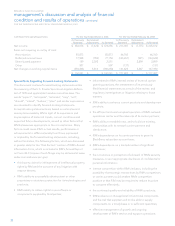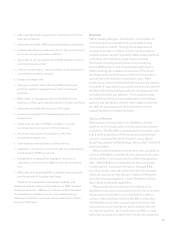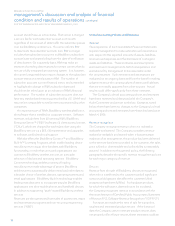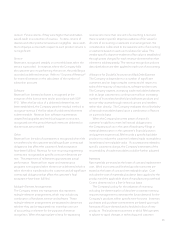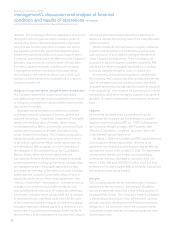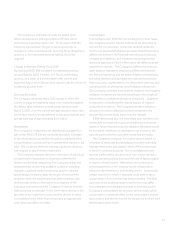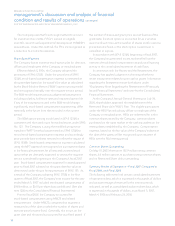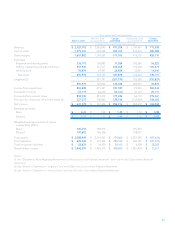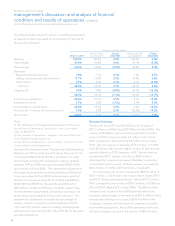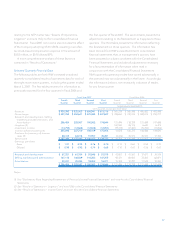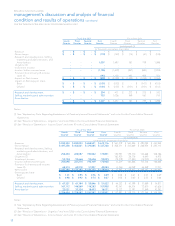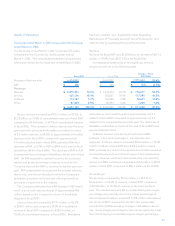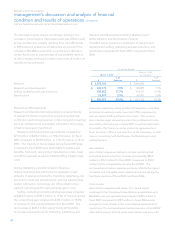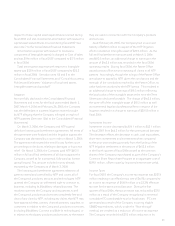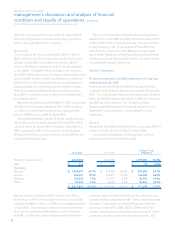Blackberry 2007 Annual Report Download - page 34
Download and view the complete annual report
Please find page 34 of the 2007 Blackberry annual report below. You can navigate through the pages in the report by either clicking on the pages listed below, or by using the keyword search tool below to find specific information within the annual report.32
RESEARCH IN MOTION LIMITED
management’s discussion and analysis of financial
condition and results of operations continued
FOR THE THREE MONTHS AND FISCAL YEAR ENDED MARCH 3, 2007
demand. The Company performs an assessment of inventory
during each reporting period, which includes a review of,
among other factors, demand requirements, component
part purchase commitments of the Company and certain
key suppliers, product life cycle and development plans,
component cost trends, product pricing and quality issues.
If customer demand subsequently differs from the Company’s
forecasts, requirements for inventory write-offs that differ
from the Company’s estimates could become necessary.
If management believes that demand no longer allows
the Company to sell inventories above cost or at all, such
inventory is written down to net realizable value or excess
inventory is written off.
Valuation of long-lived assets, intangible assets and goodwill
The Company assesses the impairment of identifiable
intangibles, long-lived assets and goodwill whenever events
or changes in circumstances indicate that the carrying value
may not be recoverable.
Intangible assets are stated at cost less accumulated
amortization and are comprised of licenses, patents and
acquired technology. A significant component of intangible
assets is the net book value of licenses. Under certain
license agreements, RIM is committed to current and future
royalty payments based on the sales of products using
certain licensed technologies. The Company recognizes its
liability for royalty payments in accordance with the terms
of the license agreements. Where license agreements are
not yet finalized, RIM recognizes its current estimates of
the obligation in Accrued liabilities on the Consolidated
Balance Sheets. When the license agreements are
subsequently finalized, the estimate is revised accordingly.
License agreements involving up-front lump sum payments
are capitalized as part of intangible assets and are then
amortized over the lesser of five years or on a per unit basis
based upon the Company’s projected number of units to
be sold during the terms of the license agreements. See
“Results of Operations – Amortization”. Unforeseen events,
changes in circumstances and market conditions, and
material differences in the value of licenses and other long-
lived assets, intangible assets and goodwill due to changes
in estimates of future cash flows could affect the fair value
of the Company’s assets and require an impairment charge.
Intangible assets are reviewed quarterly to determine if any
events have occurred that would warrant further review. In
the event that a further assessment is required, the Company
will analyze estimated undiscounted future cash flows to
determine whether the carrying value of the intangible asset
will be recovered.
Patents include all costs necessary to acquire intellectual
property such as patents and trademarks as well as legal
costs arising out of any litigation relating to the assertion
of any Company-owned patents. If the Company is not
successful in any such litigation to protect its patents, RIM
will review the related intangible asset balance, including
previously capitalized litigation costs, for impairment.
In connection with business acquisitions completed by
the Company, the Company identifies and estimates the fair
value of net assets acquired, including certain identifiable
intangible assets other than goodwill and liabilities assumed
in the acquisitions. Any excess of the purchase price over the
estimated fair value of the net assets acquired is assigned to
goodwill. Goodwill is assessed for impairment on an annual
basis.
Litigation
As more fully disclosed in the Consolidated Financial
Statements, the Company was the defendant in a patent
litigation matter brought by NTP, Inc. (“NTP”) alleging that
the Company infringed on eight of NTP’s patents (See
“Results of Operations – Litigation” and note 13(b) to the
Consolidated Financial Statements).
On March 3, 2006, the Company and NTP signed definitive
licensing and settlement agreements. All terms of the
agreement were finalized and the litigation against RIM was
dismissed by a court order on March 3, 2006. The agreement
eliminated the need for any further court proceedings
or decisions relating to damages or injunctive relief. On
March 3, 2006, RIM paid NTP $612.5 million in full and final
settlement of all claims against RIM, as well as for a perpetual,
fully-paid up license going forward.
Warranty
The Company provides for the estimated costs of product
warranties at the time revenue is recognized. BlackBerry
devices are generally covered by a time-limited warranty for
varying periods of time. The Company’s warranty obligation
is affected by product failure rates, differences in warranty
periods, regulatory developments with respect to warranty
obligations in the countries in which the Company carries
on business, freight expense, and material usage and other
related repair costs.


